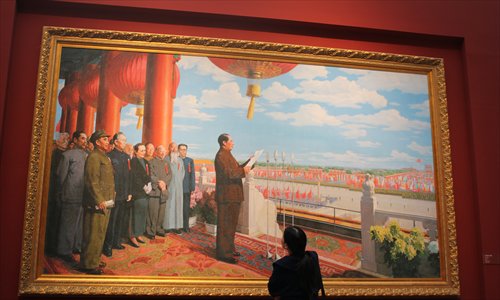Painting a nation
Exhibition memorializing artist reflects political changes in China

A visitor examines a reproduction of Dong Xiwen's The Founding Ceremony of the People's Republic of China at the CAFA Art Museum on Friday. Photo: Xu Ming/GT
For those not interested in art, the name of Dong Xiwen (1914-73) might sound unfamiliar. However, while they might not know his name, almost everyone in China is familiar with his painting The Founding Ceremony of the People's Republic of China, a popular piece of art known nationwide for its depiction of the grandness of the PRC's birth in 1949.
A pioneer artist and teacher of Chinese oil painting, Dong has created numerous works of art of great artistic and historical value that have been collected by many major museums in China.
Thanks to an ongoing exhibition at the China Central Academy of Fine Arts (CAFA) Art Museum to celebrate the 100th anniversary of Dong's birthday, people in Beijing now have the chance to take a systematic look at the works the artist created throughout his life, many of which are being displayed to the public for the first time.
Chinese-style Oil Painting assembles under one roof more than 120 pieces of Dong's work collected by several big museums such as the National Museum of China and the National Art Museum of China. Familiar names such as Baiwanxiongshi Xia Jiangnan (Millions of soldiers cross the Yangtze River) and The War to Resist US Aggression and Aid Korea are among those exhibited.
Certain sections of the exhibition specially focus on Dong's creations in Dunhuang and Tibet. During the 1940s, Dong spent several years studying and copying the Buddhist frescoes located in Dunhuang, works that greatly inspired his art throughout his career.
During the 1950 and 60s, he went to Tibet three times, each time creating many important works reflecting the changes and looks of the region and its people, as shown in works like Kazak Shepherdess and Qianniantudi Fanleshen (Emancipation of thousand-year serfs).
Apart from showing Dong's more representative works, the exhibition also boasts important works and drafts in different periods in the artist's life, including drafts of The Monument to the People's Heroes in Tiananmen Square and a draft for The Founding Ceremony of the People's Republic of China.
Though the paper the draft of The Founding Ceremony was drawn on has turned yellow with time, it has attracted particular attention since this is the first time it has been shown to the public. A family treasure, Dong used to carry this draft to meet with and ask for advice from artists like Xu Beihong, Wu Zuoren and architect Liang Sicheng.
The original draft for the famed The Founding Ceremony had been thought lost for over 50 years, it was rediscovered by Dong's family during preparations for the exhibition, a big surprise to all involved.
Political pressures
An artist who witnessed the birth of New China, Dong's life and artistic creations were closely linked to political changes in the country. Deeply affected by the Cultural Revolution (1966-76), during which time he developed cancer, his painting also suffered from a turbulent fate during that time.
On October 1, 1949, Dong took part in the parade celebrating the founding of China in Tiananmen Square. Greatly inspired, he immediately began sketching the scene in his mind.
Three years later, the 38-year-old Dong was invited to paint The Founding Ceremony. Dong's then student at CAFA, painter Jin Shangyi recollected Dong's creation of the painting in 1952 at the opening ceremony for the exhibition last Friday.
"It was the summer of 1952 and we were performing manual labor at a power plant in Shijingshan. He had just been tasked with painting the ceremony and often worked on it in his spare time. Two months later, I saw the painting in a courtyard. It was almost finished," Jin said, adding that he was amazed at the perfect combination of Western and Chinese styles.
The painting was exhibited in 1953, making the headline in the People's Daily. Chairman Mao Zedong viewed the painting three times after its debut, regarding it as a work containing a unique national style. It was also used as a memorial stamp in 1959 to celebrate the 10th anniversary of the founding of the PRC.
This classic painting, nevertheless, experienced several twists of fate connected to the political figures depicted therein. Three years after it was finished, then Vice President Gao Gang, who was painted standing in the front row of leaders in the painting, was expelled from the Communist Party. So Dong was asked to remove Gao from the painting. This was the first of many changes.
After Liu Shaoqi was reviled during the Cultural Revolution, in 1971 the cancer-plagued Dong was required to remove Liu, who was also in the front row, and replaced him with Dong Biwu, who was almost invisible in the original version.
In 1972, while Dong was undergoing chemotherapy, he was asked to remove yet another political figure, Lin Boqu. Unable to make the changes himself, his student Jin accomplished the task under Dong's guidance. Dong passed away the next year.
When the Cultural Revolution came to an end, this meant The Opening Ceremony needed to be restored to its original state. However, to protect Dong's original work, Jin was asked to make the changes on a reproduction made together with other artists. It is this work that was later shown at many important exhibitions and is part of the current exhibition.
"The painting, which was changed many times due to the rise and fall of political waves, will not be shown in order to protect it. In it, there is a painful story about Chinese art to tell," Fan Di'an, director of the CAFA, said at the opening ceremony.
The exhibition will run until January 8.